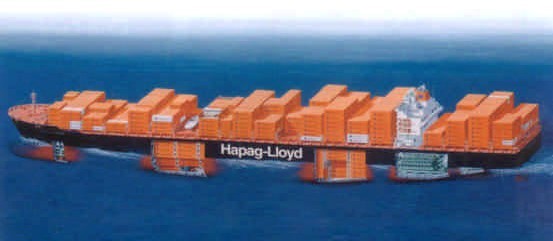Introduction to Transportation
The transportation of goods emerged when mankind started living in communities and goods had to be distributed over the various community’s members (food, fur, building materials like forest products, clay and stones). The development of cultures resulted in transportation of raw materials over longer distances (with the help of animals like mules, elephants and small vessels) and later trade lanes connected a number of cultures. Trade enabled the separation of production and consumption area’s and so transportation developed not only for the collection of raw materials but also for finished products, both for living (food, pottery) and ostentation (show). For thousands of years men, animals, vessels and carts where the only means of transportation.
Handling techniques (as a key-element for transport technology) were developed when mankind tried to move goods much heavier than himself. The inheritance of ancient cultures shows many ingenious approaches to handle the stone blocks for pyramids, the men hirs in England, France and Portugal and largest on emonuments in South Pacific isles. Religion was the major driver behind these impressive activities, only allowed through the support of transport technology. Already thousands of years, sea transportation is the dominant mode of transport and ports developed not only as places for the transshipment of goods, but also as centre where goods were stored, refined, processed and traded. Many cities developed from an early transshipment place in to a large industrialized living centre. It is amazing how many tools and techniques were developed in the last 1000 years, to support the handling of goods both for the transportation of consumer goods and for the transportation of building materials, raw materials etc.

The industrial revolution of the 19th century generates rail transportation, which further supported a separation of production and consumption centres. The speed of transportation (so far determined by sail boat, tow boat and mail-coach) increased five-fold. In the beginning of the 20th century the arrival of automobiles and trucks contributed to better services for the transportation of (smaller) goods and after the Second World War air cargo transportation emerged, mainly for the transport for time critical (high-value) products.
Nowadays transportation is an indispensable component of our society. Globalisation could develop through the support of low-cost, high-frequent transportation between almost every place in the world. Transportation really developed as a utility in our society. In an USA-study (“vision2050”) the attitude to transportation concluded: “Transportation is the foundation of our entire economy and quality of life”.
The following major modes for the transportation of cargo can be recognized.
Sea transportation
Large-scale vessels are provided mainly for the carriage of raw materials (ore, coal, crude oil etc.). Special designs are used for half or finished products (refinery products, cement, forest products, perishable goods etc.) and many half products and consumer goods are transported in to maritime containers on container vessels in size varying from 1000 tons DWT (100TEU) until 100.000 tons DWT (8000TEU). One TEU is the space-equivalent of one twenty foot container (20’x8’x8’6”#6.05x2,44x2,59m) and vessels are designed with a carrying capacity for an average of 9-12 metric tons per TEU.

The vessel sizes are determined by the trades, their volumes and economies and a number of “natural” barriers such as the water depth of ports and entrance channels, the maximum allowed sizes through Panama canal and Suez canal, the passing height of bridges (Bridge of the Americas in Panama, Verrezano bridge New York). For some commodities special vessel designs are applied such as reefer vessels for fruit (citrus, banana’s etc), roll-on / roll-off vessels for trucks and trailers, self-discharging vessels for ore and coal etc.
Coastal services have been in use for thousands of years and will continue to be important as increasing concerns about the environment and congestion on road an rail infrastructure will support are vival of coastal services with smaller specialized vessels (500-5000DWT). Transportation speeds for sea going cargo vessels vary from 12 knots (12 nauti cal miles / hour) to 25 knots (45 km / hr).
Barge transportation
For many centuries barges (with sail sort owed by menor animals) carried cargo over rivers, inland lakes and (man-made) canals, supporting the developments in trade and industrialization on side the land water ways. Nowadays motor barges carry up to 2000 ton of cargo and the towing of barges is almost entirely replaced by push-convoys (aver .4, max .6 barges in Europe, with sometimes more than 50 barges of ± 3000 tons cargo each in one convoy on the rivers Mississippi / Missouri.
Transportation speeds are only about 20 km / hr., but the large carrying capacity, the limited environmental impact and the service-approach of barge-operators makes barge transportation attractive, even for inland container trans












